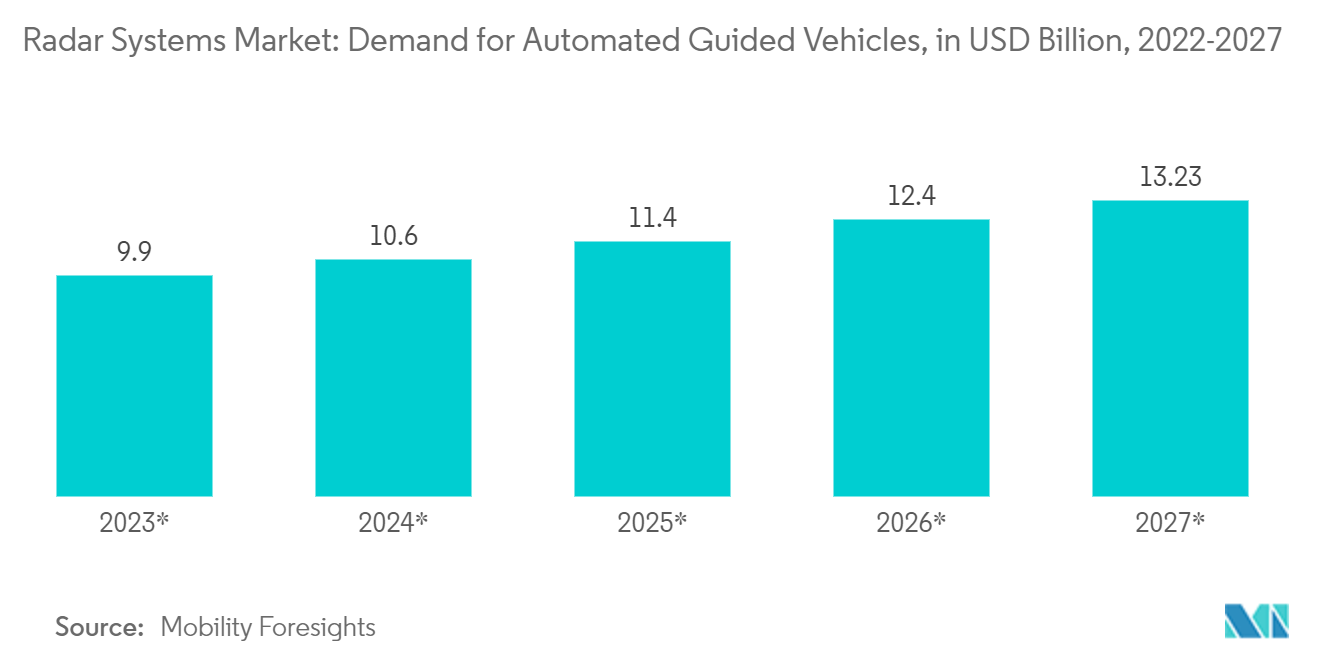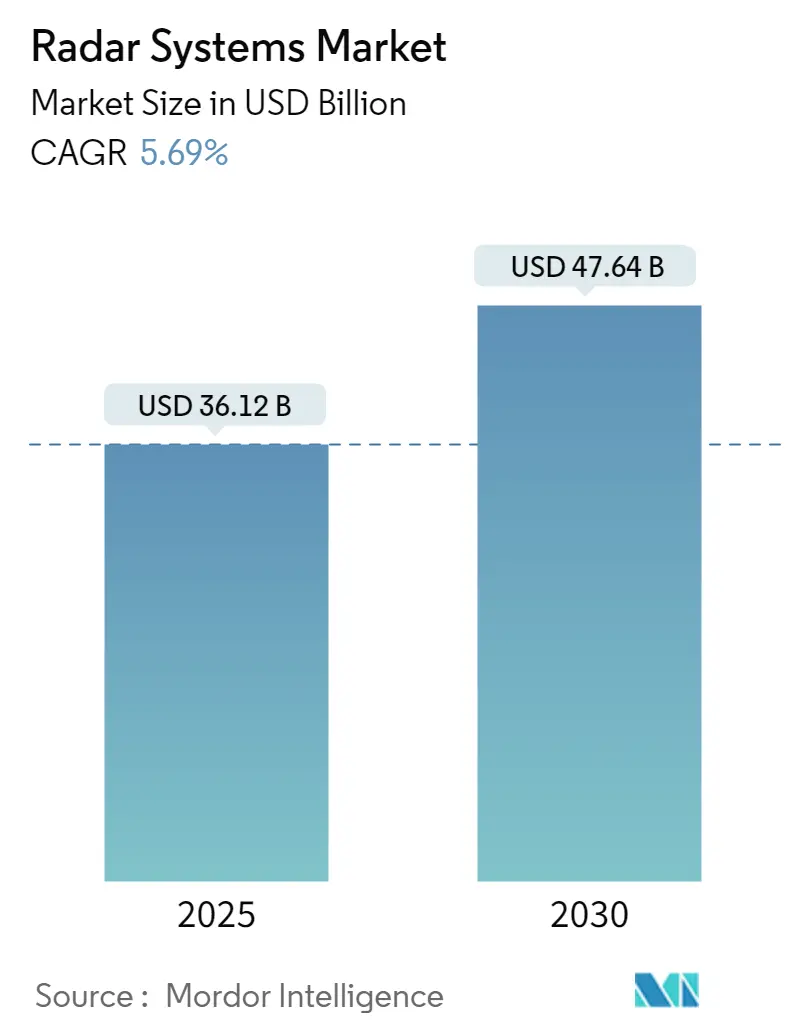
| Study Period | 2019 - 2030 |
| Market Size (2025) | USD 36.12 Billion |
| Market Size (2030) | USD 47.64 Billion |
| CAGR (2025 - 2030) | 5.69 % |
| Fastest Growing Market | North America |
| Largest Market | North America |
| Market Concentration | High |
Major Players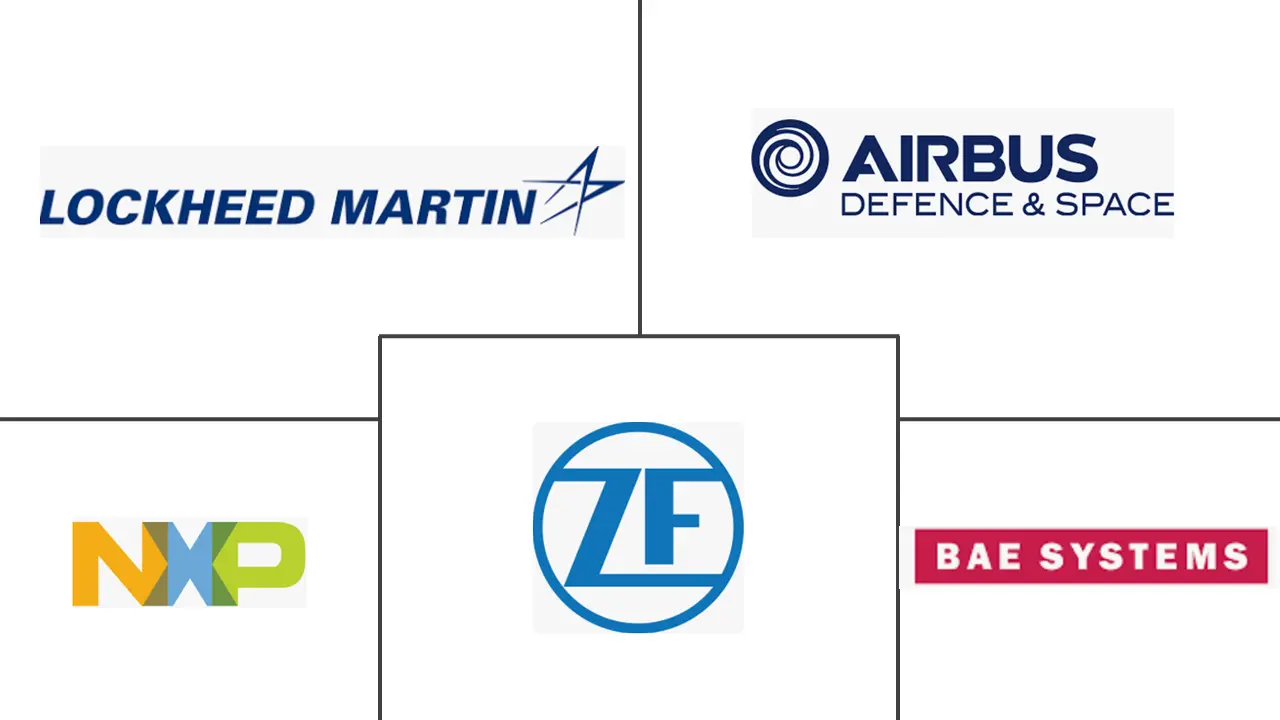
*Disclaimer: Major Players sorted in no particular order |
Radar Systems Market Analysis
The Radar Systems Market size is estimated at USD 36.12 billion in 2025, and is expected to reach USD 47.64 billion by 2030, at a CAGR of 5.69% during the forecast period (2025-2030).
Radars can be used in meteorology, aerial surveillance, and maritime domains. Radars in automobiles can help measure the speed of cars on the road. Companies are using AI technologies to develop different types of radars for various industrial applications. A significant technological advancement is laser radar, which is ideal for usage in the automotive sector.
- The worldwide spending on military and defense services has increased over the years, and countries are investing in AI-supportive technologies for security to keep their country and border safe from intruders. Japan's Self-Defense Forces deployed SPY-7 radar, developed by Lockheed Martin. When connected to the Aegis Weapon System for Japan, this radar will aid in identifying, tracking, and discriminating ballistic missile threats and successfully targeting interceptors.
- Automobile companies are investing heavily in autonomous driving solutions, the major factor behind the rising demand for automotive hardware products like domain control units, cameras, radar, safety sensors, and more. Hyundai introduced a radar-based rear occupant alert system for passenger convenience and safety at the highest level of autonomous driving. The system can detect even the slightest movement of a passenger and is composed of a radar sensor module concealed in the ceiling, CAN, and the Integrated Body-control Unit (IBU).
- The COVID-19 pandemic squeezed the world economy by affecting the manufacturing industry, production, disruption, and financial systems. Many countries reduced their budget for their defense services to overcome inflation, which affected the demand for radar systems as military services are the primary users of this application. The international trade of radar systems was also affected as companies held back their funds for non-essential collaboration.
- It is important to study the architecture of the products where the radar is being plugged for further use, as radar is often used with other sensing technologies, such as video cameras and LiDAR. Automobile radars must function in various urban, rural, and inter-state contexts. This wide range of velocities challenges the waveform design, chirp configuration, and frame size, impacting the radar functioning.
Radar Systems Market Trends
Automotive Application to Witness Significant Growth During the Forecast Period
- As Automobile players adapt to IoT, autonomous driving will revolutionize how consumers experience mobility. A study by Mckinsey predicted that the growing adoption of advanced driver-assistance systems (ADAS) in Europe could reduce the number of accidents by about 15% by 2030. The total value of the autonomous driving hardware market is expected to reach USD 80 billion by 2030. This will create a robust market for hardware products like domain control units, cameras, radars, and safety sensors.
- MMWave radars used in automotive, industrial, civil, and meteorological systems provide accurate sensing of location, velocity, and angle without any obstacle. These radars are gaining attention among automotive players for their advanced driving assistant systems (ADAS), as these can detect a collision, multi-lane, multi-object tracking and parking aids.
- Automobile companies are investing heavily in autonomous driving solutions. Hyundai announced an investment of USD 10 billion for electrification and autonomous vehicle technology. Volkswagen planned to spend USD 2.35 billion in China to stay competitive in the age of smart electric vehicles.
North America to Witness Highest Growth During the Forecast Period
- In 2022, the global spending on defense services was USD 1.981 trillion. The US military spending was approximately USD 754 billion in 2022, making it the most paying nation in the world. The region has a significant need for radar systems for aviation and maritime applications due to its strongest military base in the world.
- In August 2022, the US Northern Command's Operations Directorate confirmed the trials of Long Range Discrimination Radar (LRDR) in missile defense operational architecture. This USD 1.5 billion radar system can provide constant coverage to detect intercontinental ballistic missile (ICBM) launches by adversarial nations toward the United States.
- In April 2022, to improve continental security in conjunction with the US, the Canadian Govt. announced an investment plan of USD 1 billion for a new radar system to protect major population centers in North America. The radar system would provide long-range surveillance of northern approaches on Arctic airspace to detect threats against major United States or Canadian cities
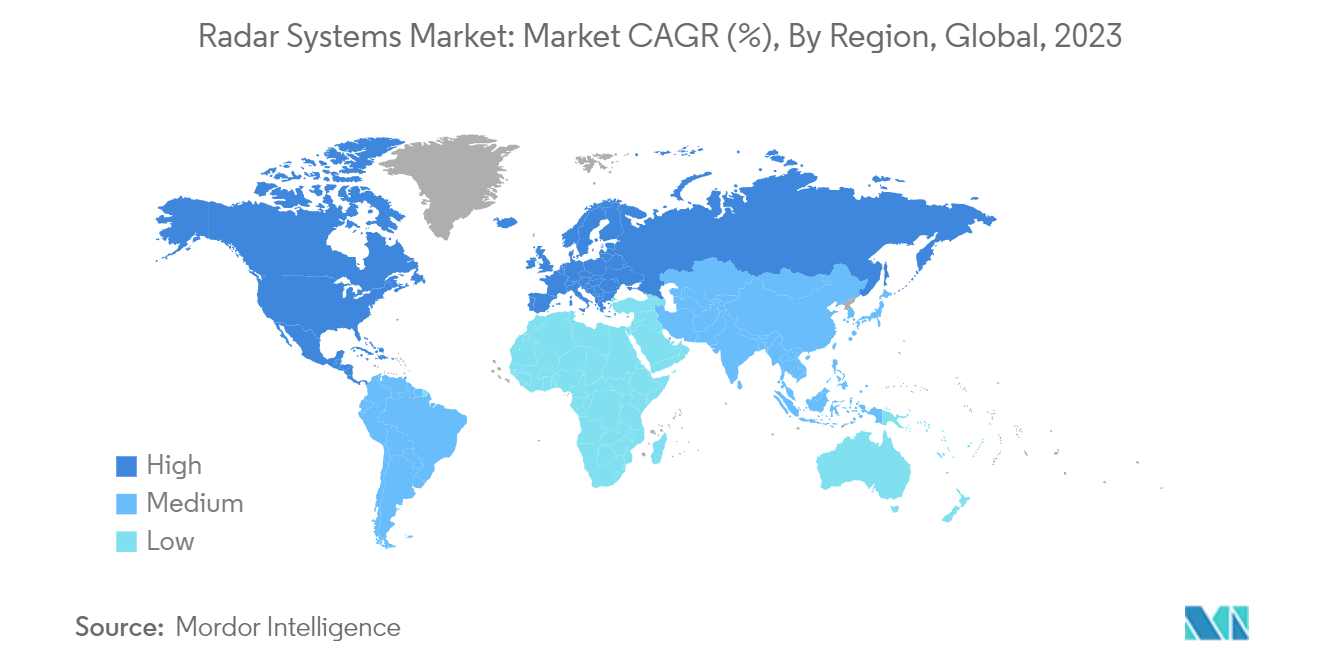
Radar Systems Industry Overview
Due to a few dominant players like Airbus SE and BAE Systems plc, the market for radar systems is trending toward consolidation. Companies like Infineon Technologies AG and NXP Semiconductors N.V. have entered the automotive radar system solutions market due to the expanding opportunities presented by automotive sector applications.
- January 2022 - Google has been working with Ford to develop an open and standardized API interface for the radar system. For general-purpose radar, standardized API calls promote interoperability and speed up the rollout of new applications. If the project remains successful, this development will lead to new consumer products and services.
- March 2022 - Uhnder launched the first 4D digital imaging radar for next-gen ADAS (advanced driver assistance systems), autonomous vehicles (AVs), and automated mobility applications. It will provide precision while minimizing interference from other radars, regardless of weather and lighting conditions. Its 4D precision will provide accuracy and an enhanced sense of standing or moving objects at short or long distances.
- January 2023 - Mobileye partnered with Wistron NeWeb Corp. (WNC) to produce software-defined imaging radars. With an integrated system-on-chip design, these radars from Mobileye provide a thorough, four-dimensional image of the environment up to and beyond 1,000 feet distant. Mobileye's prominent camera-based perception systems and the latest radar technology from the company let autonomous vehicles see and comprehend their surroundings regardless of the weather, lighting, or types of roads.
Radar Systems Market Leaders
-
Leonardo S.p.A.
-
General Dynamics Corporation
-
NXP Semiconductors N.V.
-
BAE Systems plc
-
Airbus Defense and Space, Inc. (Airbus SE)
- *Disclaimer: Major Players sorted in no particular order
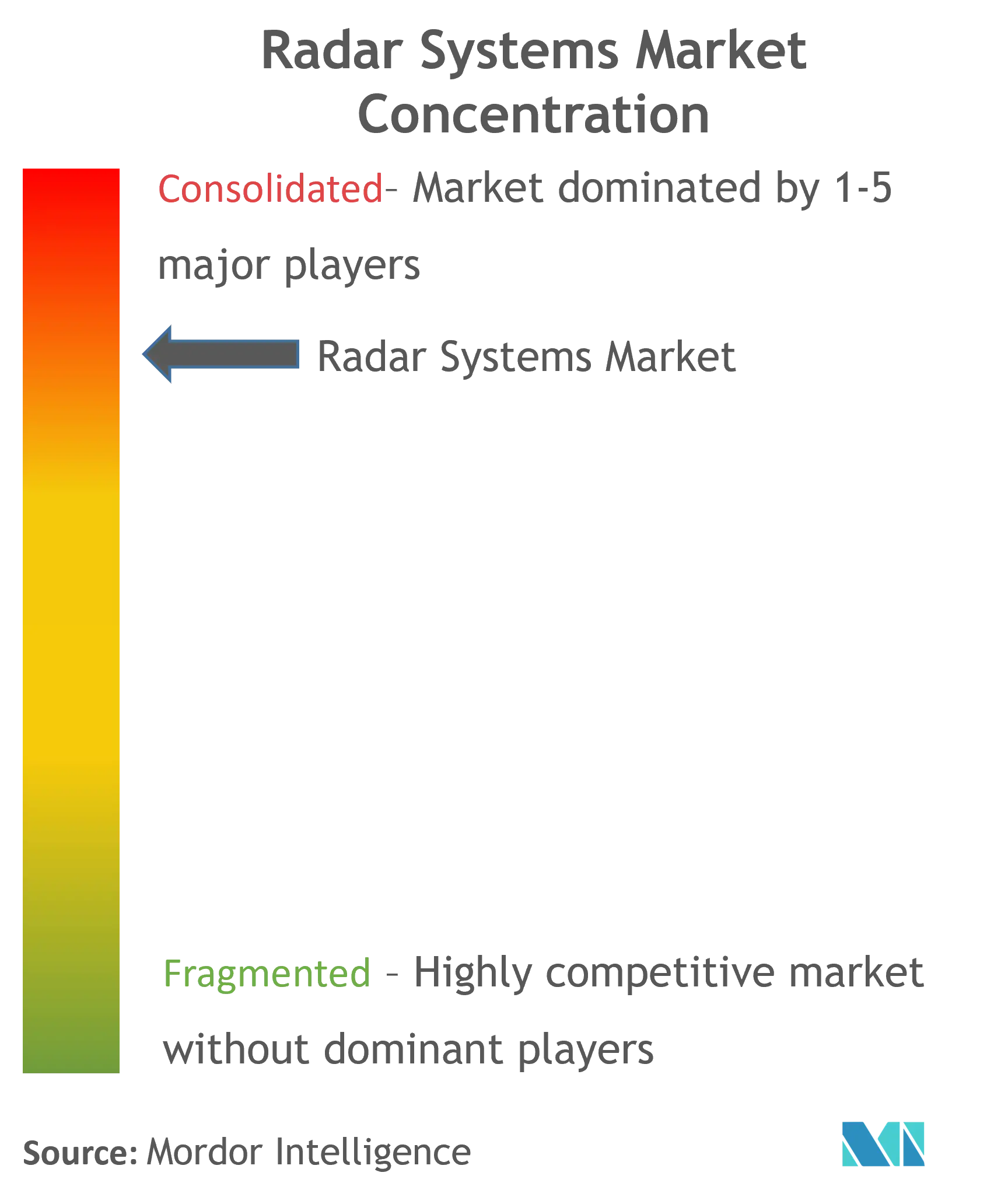
Radar Systems Market News
- January 2023 - NXP Semiconductors launched a 28nm RFCMOS radar one-chip for safety-critical ADAS applications, including automated emergency braking and blind-spot detection. DENSO, the lead client of NXP, will use this chip technology to maintain its position as the industry leader in ADAS.
- December 2022 - ZF introduced Imaging Radar technology to China's SAIC Motor Corporation. This will provide the necessary safety and reliability for autonomous driving applications. This technology enables a moving vehicle to identify the end of a traffic jam, even in a tunnel or under a bridge. If a driver does not react, the system will issue brake warnings or initiate automatic emergency braking.
- November 2022 - Renesas Electronics Corporation entered the automotive radar market by introducing transceivers designed to meet ADAS's demanding requirements (advanced driver assistance systems). The new transceiver MMIC (monolithic microwave integrated circuit) is especially suited to 4D radar and can be used with satellite automotive radar systems.
Radar Systems Industry Segmentation
The term RADAR stands for Radio Detection and Ranging. Radio waves are the foundation of radar. In a similar way to wireless computer networks and mobile phones, radars emit electromagnetic waves. It has the property to detect surrounding objects using radio waves. Radars can be used in meteorology, aerial surveillance and even the maritime domain. Radars can be used to measure the speed of cars on the road.
The radar systems market is segmented by type, application, end-user industry, and geography. By yype, the market is segmented into continuous wave RADAR Systems and pulsated wave RADAR systems). By application, the market is segmented into airborne, land-based, and naval. By end-user industry, the market is segmented into aviation, maritime applications, automotive, military and defense. The report also covers the market sizes and forecasts for the radar systems market in major countries across different regions. For each segment, the market size is provided in terms of value (USD).
| By Type | Continuous Wave RADAR Systems | ||
| Pulsated Wave RADAR Systems | |||
| By Application | Airborne | ||
| Land-based | |||
| Naval | |||
| By End-user Industry | Aviation | ||
| Maritime Applications | |||
| Automotive | |||
| Military & Defense | |||
| Geography | North America | United States | |
| Canada | |||
| Europe | United Kingdom | ||
| Germany | |||
| France | |||
| Rest of Europe | |||
| Asia-Pacific | China | ||
| Japan | |||
| India | |||
| Rest of Asia-Pacific | |||
| Rest of the World | Latin America | ||
| Middle East and Africa | |||
Radar Systems Market Research FAQs
How big is the Radar Systems Market?
The Radar Systems Market size is expected to reach USD 36.12 billion in 2025 and grow at a CAGR of 5.69% to reach USD 47.64 billion by 2030.
What is the current Radar Systems Market size?
In 2025, the Radar Systems Market size is expected to reach USD 36.12 billion.
Who are the key players in Radar Systems Market?
Leonardo S.p.A., General Dynamics Corporation, NXP Semiconductors N.V., BAE Systems plc and Airbus Defense and Space, Inc. (Airbus SE) are the major companies operating in the Radar Systems Market.
Which is the fastest growing region in Radar Systems Market?
North America is estimated to grow at the highest CAGR over the forecast period (2025-2030).
Which region has the biggest share in Radar Systems Market?
In 2025, the North America accounts for the largest market share in Radar Systems Market.
What years does this Radar Systems Market cover, and what was the market size in 2024?
In 2024, the Radar Systems Market size was estimated at USD 34.06 billion. The report covers the Radar Systems Market historical market size for years: 2019, 2020, 2021, 2022, 2023 and 2024. The report also forecasts the Radar Systems Market size for years: 2025, 2026, 2027, 2028, 2029 and 2030.
Our Best Selling Reports
Radar System Industry Report
Statistics for the 2025 Radar Systems market share, size and revenue growth rate, created by Mordor Intelligence™ Industry Reports. Radar Systems analysis includes a market forecast outlook for 2025 to 2030 and historical overview. Get a sample of this industry analysis as a free report PDF download.



